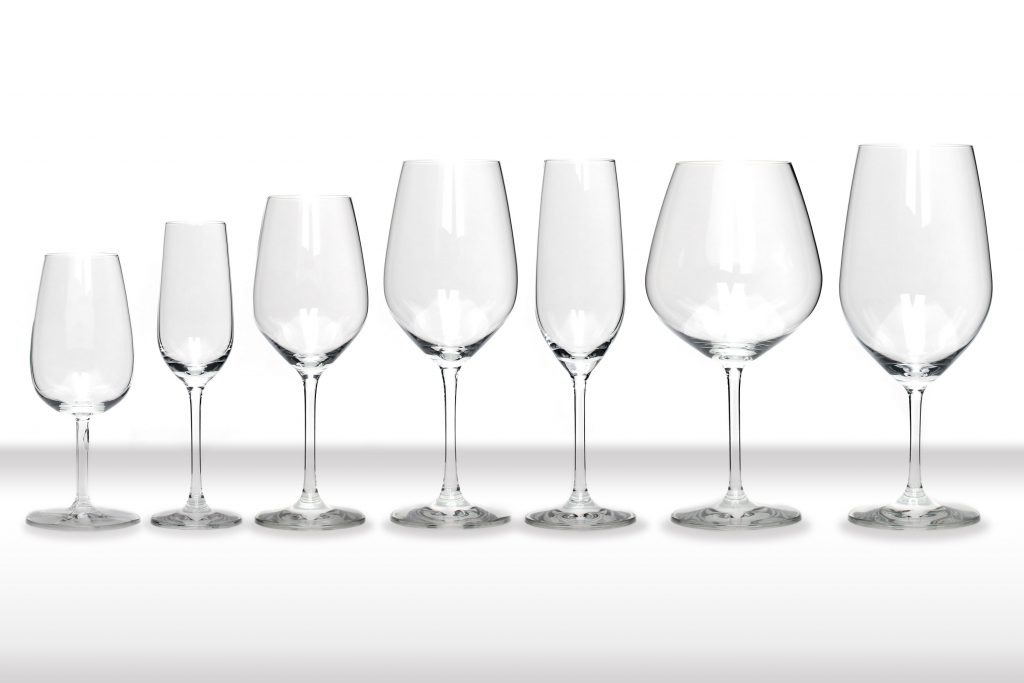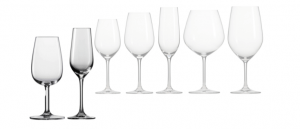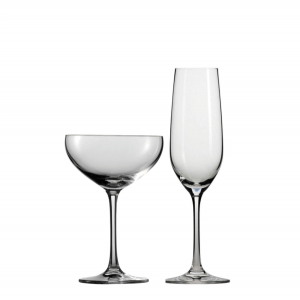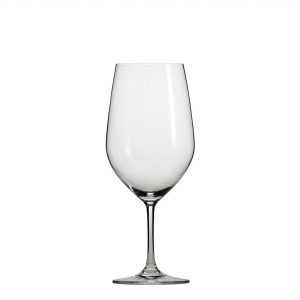The correct glass makes all the difference.
Glasses are the most important tool for our enjoyment of wine. Understanding how a wine glass affects the taste of our wines is important for enjoying any wine to its fullest potential. Preferences may vary, but there are predictable preferences that most of us will share. At BestWineGlass, we believe the most important aspect of a glass is how it makes the wine taste.
Setting aside the look (aesthetics) of the wine glass, the feel of the wine glass in our hand and even the cost of wine glasses and focusing our attention strictly on how different types of wine glasses affect the taste of our wines requires us to take a closer look at the anatomy of different types of wine glasses. There are seven basic types of wine glasses in common use today. From left to right they are, Port, Sherry, White Wine, Red Wine, Champagne, and two specialized red wine glasses, the Burgundy and the Bordeaux. The obvious differences in size and shape of different types of wine glasses make each one more suitable for different types of wine.
Specialty Glasses
The first two wine glasses are the Port wine glass and the Sherry wine glass. These specialty wines are very potent and typically consumed slowly in small amounts. The port wine glass is small because of the way port is consumed slowly in small amounts, but still large enough to swirl and capture aromatics that affect how the wine tastes. Sherry tends to be more acidic and higher in alcohol. Getting a good full breath of these hyper-sweet alcohol-rich aromatics tends to overwhelm the palate and make the wine hard to taste. The small narrow sherry glass tends to minimize the effect of sherry’s smell on it’s taste and allows the drinker to taste sherry’s subtle fruits and minerals without overwhelming one’s senses. This is why the sherry glass also makes a perfect tequila glass for tasting the finest Tequilas in the world.
White wines are generally less aromatic than red wines and usually taste better at cooler temperatures. White wines tend to have very narrow ranges of temperature at which they taste best, so serving them in smaller amounts from a larger container better able to hold its ideal temperature longer is of significant benefit. The best types of white wine glasses are 9-14 oz. It’s common to use a glass at the smaller end of this spectrum, say 9-11oz., as a “white wine glass” while using a glass at the larger end of this spectrum, say 12-14oz. as a “red wine glass.” This is not unreasonable for beginners or those with limited storage space and we sell a combo “Red/White” set of wine glasses for exactly this reason. However, we feel that this “standard” red wine glass is better for fuller-bodied, richer, bolder white wines that present stronger aromatics like full, rich and complex Chardonnays. In this way, the Red/White pair of glasses really represents the different wine glass types for the full spectrum of white wines you might enjoy. A survey of major types of white wine will reveal the difference the size of the glass can make in side-by-side comparisons.
Sparkling Wine Glasses
The fifth glass pictured needs little introduction. The “champagne flute” has become so closely associated with Champagne that few people realize that there was ever a different style used for “bubbly.” The coupe or “saucer” style was more in vogue when traditional French Champagne was only lightly bubbly. Whether enjoying a true Champagne or any other “sparkling” white wine, today’s versions tend to be extremely effervescent and are also drank ice cold. The small narrow glass is best for preserving both the effervescence and the temperature longer. Many sparkling wines are only lightly effervescent and often enjoyed at somewhat higher temperatures. Sparkling reds like Lambrusco should be enjoyed from larger types of red wine glasses and sparkling Rose’ wines should be enjoyed from smaller types of white wine glasses.
Finally, we come to the most distinctive types of wine glasses in the set. of seven basic wine glasses you must have. The sixth and seventh glasses pictured above are types of red wine glasses that any real wine lover becomes familiar with pretty quickly. These are the “burgundy” and the “bordeaux” respectively. They’re named for the famed Burgundy and Bordeaux wine-making regions in France. Both types of red wine glass are large enough to capture the wide variety of complex aromas that come from red wines.
The Burgundy Glass
The bowl of the “burgundy” glass is wider, shorter and more dramatically tapered. This shape better captures the complex aromas of the world’s best lighter red wines. The Burgundy Region of France is known for originating the best example of complex, lighter and more fruit-forward red wines like Pinot Noir. The large surface area of this glass allows each swirl to produce a large volume of aromatics and the relatively narrow rim captures them to be focused on the nose very intensely while drinking. Making it easier to smell the distinctive aromatics of a world class Pinot Noir so dramatically affects its taste that you would hardly recognize it as the same wine from a different glass in side-by-side tasting comparisons. The Burgundy glass so thoroughly captures wine aromatics and focuses them on the drinker’s nose that many are led to wonder why this is not the only type of wine glass ever needed to enjoy every wine.
Many people do think the Burgundy is the only glass they need, especially for all types of red wines. However, “more” is not always better. The exclusive use of this larger glass completely ignores the use of size and shape to better control and deliver the correct aromatics, in the correct amounts and at the correct temperature to best showcase each type of wine given each drinkers preferences. Close attention to all these important factors will help you find the correct wine glass for your enjoyment. Try your favorite fruit-forward, less-dry Pinot Noir in its correct burgundy glass. Really pay close attention to the smell and to the taste, then pour the exact same wine into your white wine glass and see how different it is immediately. Try even the larger white wine glass (the generic “Red Wine” glass) and see if it’s any better. It won’t be much better. Pour the rest back into the burgundy glass and stop torturing yourself.
The Bordeaux Glass
Perhaps the best example of why different types of wine glasses, especially different types of red wine glasses, is so important is to really experience the uses and value of the Bordeaux wine glass. Just like the burgundy glass originated along with the wines it presents best in Burgundy, France, the Bordeaux glass evolved to best present the full-bodied, richest and most aromatic red wines, like Cabernet Sauvignon, produced for many hundreds of years and perfected in the Bordeaux Region of France. As we said before, more is decidedly not always better. Many of these rich reds are also high in tannins. That’s the bitter taste and tart “pucker” factor you experience in many richer red wines.
The Bordeaux glass also has a large bowl. Like the burgundy, this enables the collection of a large amount of these aromatic compounds when you swirl. The difference with the Bordeaux is that the smaller surface area relative to the circumference of the rim tends to minimize your experience of some of the more acidic compounds, especially tannic acids common in red wines and even sometimes added as clarifying agents in the final production of the wine. Compare your fully rich, bold Cabernet Sauvignon enjoyed in the Bordeaux glass to what it’s like in the burgundy glass and you’ll see what a difference these glasses can make.
Any avid wine enthusiast will notice many of the differences using the correct glass makes in enjoying different types of wines. The more one consciously, purposefully experiments with glassware, temperature, aeration and even food pairing the more they will be rewarded with an increasing ability to find immense pleasure in the subtleties of many more types of wine. Enjoy! Never hesitate to give us a call if you have questions or anything at all we can help you with. (312) 981-9127
Cheers!
Alana

















